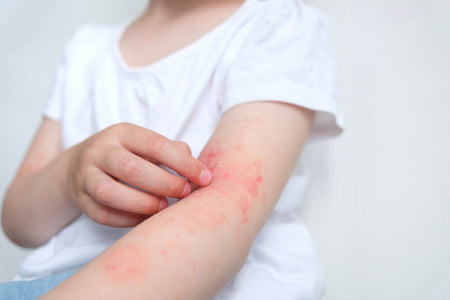- Individuals can be allergic to different substances, such as pollen, medications, food, and insect venom.
- Allergy symptoms can range from mild to severe.
- Combining allergen avoidance with appropriate medication can provide more comprehensive management of allergic reactions.
Allergies happen when your body's immune system reacts to something harmless, like pollen or certain foods as if it were dangerous. This overreaction can trigger symptoms like sneezing, itching, or even more serious issues, depending on the type of allergy.
Allergies are incredibly common and they affect more than 50 million Americans. Moreover, they lead to 3.1 million missed work days per year [*]. Given their widespread impact, it’s important to familiarize yourself with the different types of allergies and the ways they might affect you and your loved ones.
Types of Allergies
Below, we’ll cover seven common types of allergies so you can stay informed and take the necessary steps to avoid or manage them.
Pollen Allergy
Pollen allergy, also known as hay fever or seasonal allergic rhinitis, is a common condition where the immune system overreacts to pollen from trees, grasses, or weeds. Examples include pollen from birch trees, ragweed, and various types of grasses like Bermuda or Timothy grass.
When an individual with this allergy inhales pollen, their immune system mistakenly identifies it as a harmful substance and releases chemicals like histamine to combat it.
This reaction leads to inflammation and irritation of the nasal passages, eyes, and throat. Symptoms typically include sneezing, runny or stuffy nose, itchy or watery eyes, and a scratchy throat.
The severity of symptoms can vary depending on the type and amount of pollen in the air, and they often worsen during peak pollen seasons.
Drug Allergy
Drug allergy occurs when the immune system mistakenly identifies a medication as a harmful substance. As a result, it triggers an abnormal immune response.
This reaction can range from mild to severe and may involve symptoms such as skin rashes, itching, hives, swelling, or more severe manifestations like difficulty breathing or anaphylaxis — a life-threatening reaction that requires immediate medical attention.
Unlike drug side effects, which are predictable and dose-dependent, drug allergies are unpredictable and occur even at low doses. The immune system's reaction involves the production of specific antibodies or sensitization to the drug, which leads to inflammation upon subsequent exposure.
Food Allergy
Food allergy is a condition that affects approximately 8 percent of children and nearly 11 percent of adults in the United States [*]. It happens when the body mistakenly identifies a specific food protein as a harmful substance.
Their immune system overreacts and triggers symptoms that can vary from mild issues such as itching, hives, and stomach cramps to severe reactions like difficulty breathing, swelling of the throat, or anaphylaxis, which is a life-threatening emergency.
Food allergies can develop at any age, but they are often first identified in childhood. Common types of food allergy include peanuts, tree nuts, shellfish, milk, eggs, and soy.
Related: Can Drinking Coffee Lead to Allergy Symptoms?
Insect Venom Allergy
Insect venom allergy is an immune system reaction triggered by the venom or other substances introduced into the body through insect stings or bites.
Hymenoptera insects — such as bees, wasps, hornets, yellow jackets, and certain ants — are known for causing most of the serious allergic reactions and fatalities due to stings [*]. They can inject venom that contains proteins capable of causing an allergic reaction in sensitive individuals.
Symptoms of an insect allergy range from localized reactions, such as redness, swelling, and pain at the sting site, to more severe systemic reactions including widespread hives, difficulty breathing, and anaphylaxis, a life-threatening condition that requires immediate medical intervention.
It’s important to note that insect allergies can develop suddenly, even in individuals who previously had no adverse reactions to insect stings or bites.
Latex Allergy
Latex allergy is an immune system reaction to proteins found in natural rubber latex, which is a material commonly used in medical gloves, balloons, and various other products.
Certain groups are at higher risk for latex allergy due to frequent exposure to latex products. For example, patients undergoing multiple surgeries, like those with spina bifida, have a higher chance of developing latex allergies, with prevalence rates between 40% and 65% in this group [*].
Healthcare workers are also at significant risk due to their frequent use of latex gloves, with about 9.7% experiencing latex allergy and 12.4% showing signs of sensitization. Other workers, such as those in the rubber industry, hairdressers, and housekeepers, are also at risk [*].
Even people who don't work with latex can develop latex sensitization or allergy, though it's less common.
Latex allergy symptoms can range from mild irritation such as itching, redness, and hives to more severe reactions including difficulty breathing, swelling, and anaphylaxis.
Pet Allergy
Pet allergy is an immune system reaction triggered by proteins found in the skin cells, saliva, urine, and feces of furry animals, such as cats and dogs. These proteins can become airborne or settle on surfaces, which causes allergic responses in sensitive individuals.
Common symptoms of pet allergy include sneezing, runny or stuffy nose, itchy eyes, and skin rashes, while more severe reactions may involve asthma symptoms like wheezing and difficulty breathing.
If you're thinking about getting a pet, it's important to check if you have any pet allergies before making the decision.
Mold Allergy
Mold allergy is an immune system reaction to spores released by mold — a type of fungus that thrives in damp and humid environments.
Mold allergies can worsen asthma symptoms because mold spores can irritate the airways. This irritation can make asthma symptoms like wheezing, coughing, shortness of breath, and chest tightness more severe.
Damp environments like bathrooms, basements, and other areas with water damage are prone to mold growth. Therefore, it’s important to keep these areas dry and well-ventilated through regular cleaning and addressing any leaks.
Related: Mold in Your House
Dust Mite Allergy
Dust mite allergy is an allergic reaction to tiny bugs, called dust mites, that live in household dust. These mites thrive in warm areas and are commonly found in bedding, upholstered furniture, carpets, and curtains.
Symptoms of dust mite allergies include sneezing, stuffy or runny nose, coughing, and itchy and watery eyes. Washing your bedding regularly and using allergen-proof covers are some of the steps you can take to keep your environment allergen-free.
Related: Dust Mite Bites: Symptoms, Prevention, and FAQ
The Bottom Line
Knowing how different types of allergies affect you can be an important first step to avoiding triggers and managing your health. Avoiding allergens is a key strategy in managing allergies, but it may not always eliminate allergic reactions entirely.
This is why additional measures may be necessary. Over-the-counter and prescription medications like oral antihistamines help to alleviate symptoms.
Nasal sprays are an option for individuals with allergic rhinitis symptoms like sneezing, itching, and congestion. For comprehensive, adaptable relief with fewer side effects — consider Allermi nasal spray.
References:
- Allergy Statistics In The US. (2020b, April 30). Allergy & Asthma Network. https://allergyasthmanetwork.org/allergies/allergy-statistics/
- Food Allergy. (2023, March 8). NIAID: National Institute of Allergy and Infectious Diseases. https://www.niaid.nih.gov/diseases-conditions/food-allergy
- Tracy, J. M. (2011). Insect Allergy. Mount Sinai Journal of Medicine a Journal of Translational and Personalized Medicine, 78(5), 773–783. https://doi.org/10.1002/msj.20286
- Nucera, E., Aruanno, A., Rizzi, A., & Centrone, M. (2020). Latex Allergy: Current Status and Future Perspectives Journal of Asthma and Allergy, Volume 13, 385–398. https://doi.org/10.2147/jaa.s242058









